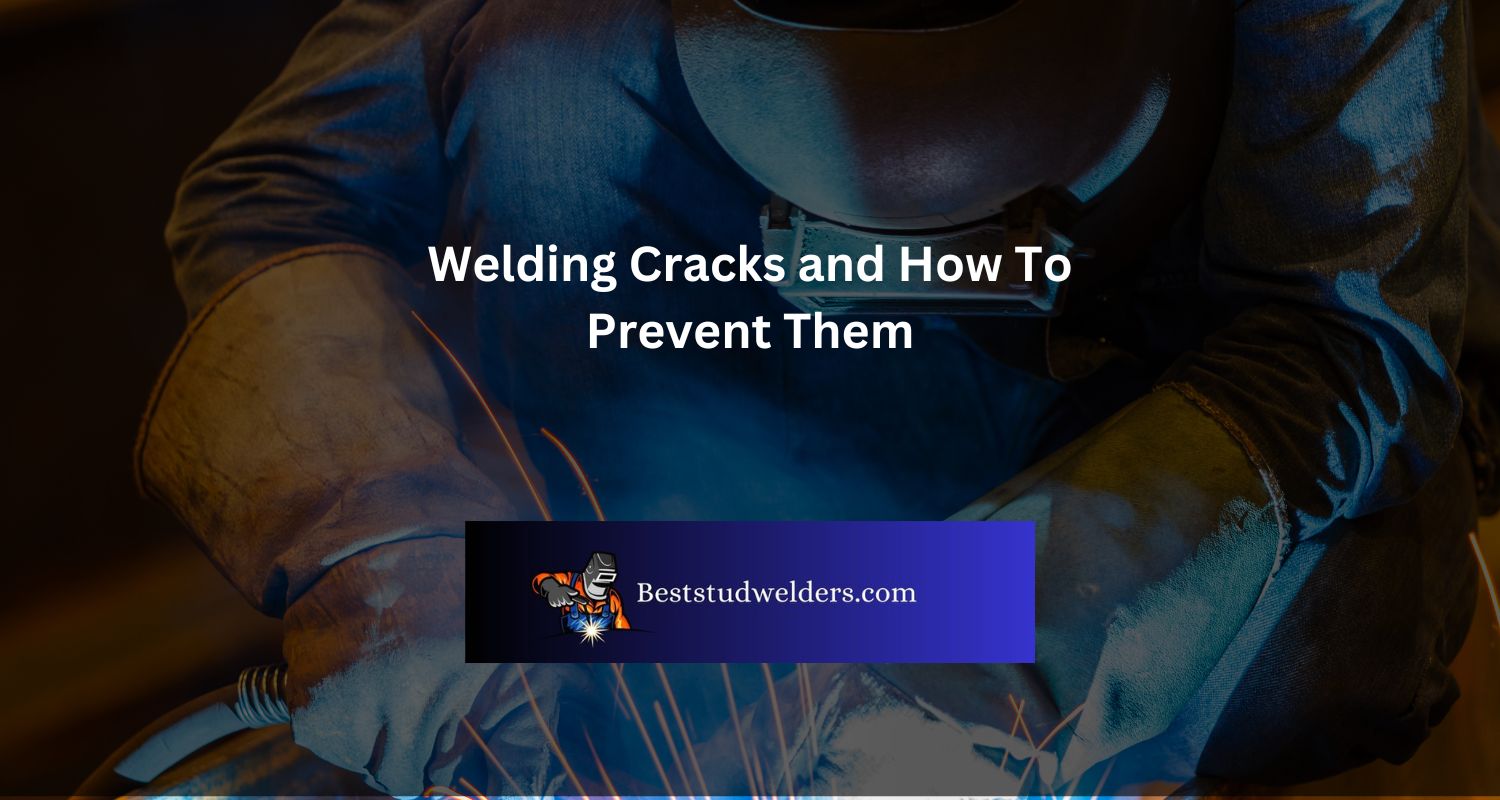If your welding projects are plagued by cracks, you know the frustration they can cause.
But it doesn’t have to be this way; understanding why these defects occur and how to avoid them is the first step in ensuring a quality weld job every time.
In this guide, we’ll cover everything from what causes cracks in welds to how heat input impacts crack formation giving you the tools and knowledge needed for achieving flawless project results.
Read on, and learn how you can become an expert at preventing unsightly welding problems caused by cracking.
Understanding Welding Cracks
Welding cracks are a major issue for welders. Understanding them is essential for welding quality products. When metal cools and shrinks, it causes the particles to separate. Cracks can be longitudinal, transverse, underbead, crater, or toe.
To prevent welding cracks, prepare and clean materials first. Use the right welding equipment and techniques as well. Select a filler material that matches the original material’s strength.
Inspect workpieces for signs of cracking. Avoid too much heat input during welding – no preheating above recommended temperatures. This helps prevent thermal stress and cracking.
Recently, a team of newbie welders learned a lesson. They found numerous cracks due to incorrect preparation and techniques.
Causes of Welding Cracks
To understand the causes of welding cracks with brittle fracture, heat affected zone cracking, and hydrogen-induced cracking as solution. These sub-sections identify the three leading causes of welding cracks and offer insights into how they can be prevented.
By exploring the root causes and prevention strategies of each sub-section, you can take proactive measures to avoid welding cracks and ensure a strong, lasting weld.
Brittle Fracture
A “snap” is what we call a fracture that happens suddenly with little to no warning. This is known as a Brittle Fracture. To make sure welding processes are successful, materials need to be able to withstand this type of failure.
Brittle Fractures occur when the material is under too much pressure for its strength and toughness. On a microscopic level, welded metal can become weak due to many factors like cooling rate, alloy composition, and hydrogen susceptibility.
Improper welding techniques such as too much heat input, high weld speed, poor preparation, and incorrect electrode placement can also cause Brittle Fractures.
It’s important to recognize areas that are vulnerable to Brittle Fractures during the welding process. Otherwise, minor oversights can lead to major disasters.
The Tacoma Narrows Bridge is an example of the destruction caused by Brittle Fractures. The suspension bridge opened in 1940 and was destroyed only four months later. Even though the welds had been designed for plates up to two inches thick, the steel was not ductile enough and the fabrication was not of good quality. So, when the bridge was exposed to strong winds, it collapsed.
Heat Affected Zone Cracking
High temperatures can cause welding joints to crack. Heat Affected Zones (HAZ) are highly susceptible to this. In the HAZ, temperature changes can create cracks due to the different rates of cooling for the base metal and other parts. Residual stress and expansion/contraction can also cause problems.
Prevention is key:
- use materials with low carbon equivalent, or add silicon, molybdenum, or chromium.
- Ensure good mechanical strength and filler material selection.
- Monitor welding parameters and avoid incorrect techniques.
Hydrogen-Induced Cracking
Excess hydrogen in base and filler metals can lead to thermal cracks: ‘hydrogen embrittlement’. These can grow into massive fractures, damaging welded components. Hydrogen is generated during welding and absorbed by molten metals, causing high hydrogen concentration zones which can crack.
Studies show that incorrect gas shielding, inadequate drying or heating pre-welding can cause porous microstructures or unstable crystal lattice formation, meaning potential creeks and fractures under pressure.
High-strength steels with tensile strength over 90 KSI are very prone to HIC, as their hardness increases susceptibility. Controlling factors and managing the process helps prevent this type of crack formation.
Preventing Welding Cracks
To prevent welding cracks while welding, you need to follow certain procedures and take necessary measures. In order to achieve a flawless weld, proper welding procedure, pre-welding preparation, material selection and preparation, and post-welding measures are your go-to solutions. These four sub-sections aim to provide you with a comprehensive understanding and knowledge of how you can prevent welding cracks.
Proper Welding Procedure
For top-notch welding results, the proper protocol must be followed. Here’s how:
- Cleanliness matters. Clear the surface of contaminants before welding to prevent cracks.
- Select the right technique. The right technique for your project helps to avoid cracking.
- Allow cooling. After welding, let it cool naturally. Temperature shocks can cause cracks.
Take pre-welding steps to find potential sources of cracking. Ensure quality control by following these guidelines!
Pre-Welding Preparation
Prior to welding, preparations must be made. Five steps that will raise weld quality and prevent cracking are:
- Preheating – Heat metals to the correct temperature according to thickness and type.
- Surfaces clean – Remove oils, rust, paint, and dirt to avoid contamination.
- Joint prep – Shape edges for ease during welding, get rid of additional filler material, and adjust gap tolerances.
- Material choice – Utilize compatible materials that meet certain requirements.
- Test – Thoroughly inspect materials before welding; cracks or breakage can lead to welding errors/defects.
Keep your gear clean and serviced for accurate readings and successful outcomes.
Pro Tip: Execute stress-relieving techniques after welding processes have been finished to increase toughness and reduce internal stresses caused by quick cooling.
Material Selection and Preparation
For a successful welding process, material selection and preparation is key! Low-crack materials such as austenitic stainless steel or aluminum alloys are great picks. Ensure surfaces are clean – no rust, oil, grease, paint, etc. – and preheat the material to avoid rapid cooling and shrinking.
Look out for defects like porosity and inclusions, and check chemical composition and physical state. When welding two thin metals, use a Copper/Molybdenum/Aluminum backing plate for extra protection.
Additionally, Gas Shielding or Flux Beads can help protect molten metal from airborne molds. With proper material selection, preparation, and other factors, welding cracks can be prevented!
Post-Welding Measures
After welding, certain steps must be taken to reduce the chance of welding cracks. These are known as Post-Welding Policies. One of the most important is a thorough inspection of the welded area. It helps detect minor cracks and identify areas that need more reinforcement.
Heat treatment, or stress relieving, is another important post-welding practice. It stabilizes the metal structure and eliminates tension due to welding and cooling. Shot blasting and grinding are also post-welding policies, which help clear away slag or dirt around the welded area.
To make the weld stronger, it’s wise to use non-destructive tests such as X-rays, ultrasound examination, and magnetic particle inspections. These tests spot any issues within the welds which could cause cracking.
It’s reported that a terrible explosion in Chattanooga, Tennessee rail yards was caused by benzene entering an underground pipeline through microcracks formed during welding. The investigation found that some welding safety protocols had been skipped before they installed the pipeline joints, leading to the tragedy that cost many lives.
.jpg)
Tools and Techniques for Detecting Welding Cracks
To detect welding cracks and prevent faulty welds, use various techniques such as visual inspection, dye penetrant inspection, magnetic particle inspection, and ultrasonic testing. Each technique has its unique features and effectiveness. These techniques help to identify welding defects early, avoid future complications, and ensure proper welding quality.
Visual Inspection
Visual examination is an essential non-destructive testing technique. With it, an inspector looks for any cracks on the material surface. This requires technical skills to detect welding flaws.
Inspectors must consider the joint contour, surface finish, and dimensions. They must also check for discolorations, spatters, pits, or other abnormalities. Seeing details clearly is key, so they need proper lighting and viewing angles, as well as equipment like a magnifier or illuminated viewer.
Documenting faults is important too. Certification is necessary to reduce errors and costs. Without accurate visual inspection, product quality control can suffer. This can result in dangerous hazards and poor performance, so don’t take the risk! Visual inspections give assurance that welding meets standards and can prevent disasters.
Dye Penetrant Inspection
Color Penetration Analysis for Welding Cracks – A great technique for detecting welding cracks. It involves applying penetrant fluid to the surface cracks, which are then visible under UV light.
Table of advantages/disadvantages for each method type:
| Method Type | Advantages | Disadvantages |
|---|---|---|
| Fluorescent | High sensitivity | Needs dark environment |
| Visible | Easily accessible | Low sensitivity |
| Water Washable | Easy cleanup | Limited capabilities |
This dye penetrant inspection can be used on various materials and shapes.
One example of its use was on an offshore platform. A small crack was detected in a weldment, which could have caused a lot of damage. The repair was done in time, thanks to this technique!
Magnetic Particle Inspection
Identifying Welding Cracks: Knowing Magnetic Particle Inspection
MPI, or Magnetic Particle Inspection, is a non-destructive testing procedure. It discovers breaks on the surface and even slightly underneath it of ferrous metals. This approach involves magnetizing the part under investigation and sprinkling iron oxide magnetic particles.
They are pulled to areas of magnetic flux leakage caused by any cracks current in the material. These particles create linear signs that follow the direction of the flux leakage, conveying the area, size and direction of surface or slightly subsurface holes.
Here’s the brief of MPI:
| Features | Description |
|---|---|
| Magnetic field | Part magnetized using an internal or external magnetic field creating flux leakage. |
| Magnetic particle suspension | A solution of suspended iron oxide magnetic particles is applied to the part’s surface. |
| Magnetic particle indication formation | Particles collect along any discontinuity path across the magnetic field, making a sign that looks like a crack line. |
| Cleanup after inspection | Remove all observable indicator marks after inspection using agents such as paint thinner or solvents. |
To be sure of accurate testing, MPI needs the right equipment setup, calibration and usage of proper operating procedures by qualified technicians with certifications. MPI can detect both surface breaking cracks and those just under machined surfaces or heat-affected zones from welding. It is applicable in many industries, including aerospace, automotive and oil & gas.
To stop unnecessary failures and dodge damage to expensive equipment, it is essential to normally employ MPI testing in the welding process. Ignoring this inspection can lead to costly rework, downtime or even serious accidents.
Ultrasonic Testing
Detecting welding cracks with sound waves is an efficient testing method. High-frequency sound energy travels through the metal and detects any irregularities in the reflection of the waves. This method can easily identify flaws in welded joints, material thickness, and internal defects.
Ultrasonic Testing has various methods and uses:
- Pulse-Echo evaluates from a single-sided access.
- Through-Transmission finds internal discontinuities with opposite side access.
- Dual Element uses two transducers for accurate measurements.
- Time-of-Flight Diffraction (TOFD) identifies depth and length of flaws.
A unique aspect is no physical contact between the tester and material is needed. It also provides quantitative data to determine weld quality and offers versatility for multiple materials.
To find cracks with Ultrasonic Testing, skilled technicians must interpret results accurately. Not enough training may cause false positives/negatives or misinterpretation of data, leading to future issues.
Don’t risk compromising your project’s safety and efficiency. Contact certified experts for reliable results.
Repairing Welding Cracks
To repair welding cracks, you need to follow a few simple steps. With ‘Repairing Welding Cracks’ in mind, the focus should be on preventing any potential issues from cracking further. To achieve this, you should look at the sub-sections – Grinding Cracks, Welding Repair, Filling and Sealing Cracks. Each of these provides a unique solution to help repair welding cracks.
Grinding Cracks
Grinding down small cracks in welded materials is a common repair solution. Use a grinding wheel to remove surface abnormalities. Pay attention to speed and pressure to prevent further damage. Wear protective gear to stay safe.
Consider the depth of the crack. If too deep, additional repairs may be needed. Consult with experienced professionals for help.
Neglecting cracks can lead to bigger problems. Take action quickly and use all welding repair techniques available.
Welding Repair
Cracks in welding can be a common issue, causing defects and weakening material strength. To fix them, it is important to identify and analyze the cause. Preheating and cleaning are two techniques to help repair the area; fusion and surface welding may also be used.
Filler materials with similar characteristics to the metal can also be used. Repairs may not guarantee structural integrity so stress testing is important.
My friend who runs a welding shop had an order from a customer who needed 40 feet long steel containers. During production preparations, a welder found tiny hairline fractures. They prepped up the work station and repaired them. Stress testing yielded positive results that saved both sides from future lawsuits.
Filling and Sealing Cracks
Crack Management! How to repair welding cracks? Here’s a 3-step guide.
- Examine the crack’s depth, width and length.
- Clean the area with a wire brush and degreaser.
- Weld or braze/polymer fill depending on the metal type.
It is critical to check for stress points before setting up welding joints or using machinery. Jominy and Thomson’s study shows brittle materials can fail under low strain rates due to external factors like misalignment and residual stresses.
Conclusion
The need to prevent welding cracks is essential. To keep cracking to a minimum, welders should observe temperature, select the right filler material and use the right equipment. Different metals may need different welding techniques to avoid cracking.
Knowing the metal properties before starting is key. Staying up-to-date with best practices and continuing education in the field can help prevent cracking and boost safety.
In 1987, a significant gas pipeline incident happened in Alabama due to poor welding processes and resulting cracks and leaks. This was an essential reminder of how important it is to use proper preventative measures to control welding crack occurrence.
Frequently Asked Questions
How can welding cracks be prevented?
To prevent welding cracks, you should ensure that you use the correct welding techniques and equipment, clean the welding environment, preheat the base materials, and match the filler materials to the base materials.
What should I do if I find welding cracks in my work?
If you find welding cracks in your work, you should immediately stop the work and assess the extent of the damage. You may need to grind out the cracks and weld them again or replace the damaged material entirely.
Is it possible to repair welding cracks?
Yes, it is possible to repair welding cracks. However, the success of the repair largely depends on the severity and location of the crack. You should consult a welding expert to assess whether or not a repair is possible.
Can welding cracks be detected before they occur?
It is possible to detect the risk of welding cracks before they occur by using non-destructive testing methods such as x-ray or ultrasound. These methods can detect any imperfections in the weld before they become a problem.
Paul Dixon is a certified welder with a wealth of experience in welding and related technologies. He started his career as an apprenticeship in welding, where he learned the ropes and acquired extensive skills in the craft.
Over the years, Paul has continued to sharpen his expertise, earning him top-rated welding certification. He remains one of the most outstanding welders in the industry.







